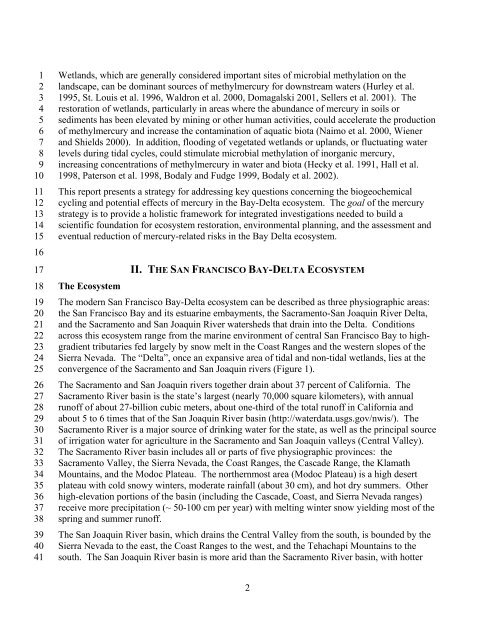Mercury Strategy for the Bay-Delta Ecosystem - CALFED Bay-Delta ...
Mercury Strategy for the Bay-Delta Ecosystem - CALFED Bay-Delta ...
Mercury Strategy for the Bay-Delta Ecosystem - CALFED Bay-Delta ...
You also want an ePaper? Increase the reach of your titles
YUMPU automatically turns print PDFs into web optimized ePapers that Google loves.
1<br />
2<br />
3<br />
4<br />
5<br />
6<br />
7<br />
8<br />
9<br />
10<br />
11<br />
12<br />
13<br />
14<br />
15<br />
16<br />
17<br />
18<br />
19<br />
20<br />
21<br />
22<br />
23<br />
24<br />
25<br />
26<br />
27<br />
28<br />
29<br />
30<br />
31<br />
32<br />
33<br />
34<br />
35<br />
36<br />
37<br />
38<br />
39<br />
40<br />
41<br />
Wetlands, which are generally considered important sites of microbial methylation on <strong>the</strong><br />
landscape, can be dominant sources of methylmercury <strong>for</strong> downstream waters (Hurley et al.<br />
1995, St. Louis et al. 1996, Waldron et al. 2000, Domagalski 2001, Sellers et al. 2001). The<br />
restoration of wetlands, particularly in areas where <strong>the</strong> abundance of mercury in soils or<br />
sediments has been elevated by mining or o<strong>the</strong>r human activities, could accelerate <strong>the</strong> production<br />
of methylmercury and increase <strong>the</strong> contamination of aquatic biota (Naimo et al. 2000, Wiener<br />
and Shields 2000). In addition, flooding of vegetated wetlands or uplands, or fluctuating water<br />
levels during tidal cycles, could stimulate microbial methylation of inorganic mercury,<br />
increasing concentrations of methylmercury in water and biota (Hecky et al. 1991, Hall et al.<br />
1998, Paterson et al. 1998, Bodaly and Fudge 1999, Bodaly et al. 2002).<br />
This report presents a strategy <strong>for</strong> addressing key questions concerning <strong>the</strong> biogeochemical<br />
cycling and potential effects of mercury in <strong>the</strong> <strong>Bay</strong>-<strong>Delta</strong> ecosystem. The goal of <strong>the</strong> mercury<br />
strategy is to provide a holistic framework <strong>for</strong> integrated investigations needed to build a<br />
scientific foundation <strong>for</strong> ecosystem restoration, environmental planning, and <strong>the</strong> assessment and<br />
eventual reduction of mercury-related risks in <strong>the</strong> <strong>Bay</strong> <strong>Delta</strong> ecosystem.<br />
The <strong>Ecosystem</strong><br />
II. THE SAN FRANCISCO BAY-DELTA ECOSYSTEM<br />
The modern San Francisco <strong>Bay</strong>-<strong>Delta</strong> ecosystem can be described as three physiographic areas:<br />
<strong>the</strong> San Francisco <strong>Bay</strong> and its estuarine embayments, <strong>the</strong> Sacramento-San Joaquin River <strong>Delta</strong>,<br />
and <strong>the</strong> Sacramento and San Joaquin River watersheds that drain into <strong>the</strong> <strong>Delta</strong>. Conditions<br />
across this ecosystem range from <strong>the</strong> marine environment of central San Francisco <strong>Bay</strong> to highgradient<br />
tributaries fed largely by snow melt in <strong>the</strong> Coast Ranges and <strong>the</strong> western slopes of <strong>the</strong><br />
Sierra Nevada. The “<strong>Delta</strong>”, once an expansive area of tidal and non-tidal wetlands, lies at <strong>the</strong><br />
convergence of <strong>the</strong> Sacramento and San Joaquin rivers (Figure 1).<br />
The Sacramento and San Joaquin rivers toge<strong>the</strong>r drain about 37 percent of Cali<strong>for</strong>nia. The<br />
Sacramento River basin is <strong>the</strong> state’s largest (nearly 70,000 square kilometers), with annual<br />
runoff of about 27-billion cubic meters, about one-third of <strong>the</strong> total runoff in Cali<strong>for</strong>nia and<br />
about 5 to 6 times that of <strong>the</strong> San Joaquin River basin (http://waterdata.usgs.gov/nwis/). The<br />
Sacramento River is a major source of drinking water <strong>for</strong> <strong>the</strong> state, as well as <strong>the</strong> principal source<br />
of irrigation water <strong>for</strong> agriculture in <strong>the</strong> Sacramento and San Joaquin valleys (Central Valley).<br />
The Sacramento River basin includes all or parts of five physiographic provinces: <strong>the</strong><br />
Sacramento Valley, <strong>the</strong> Sierra Nevada, <strong>the</strong> Coast Ranges, <strong>the</strong> Cascade Range, <strong>the</strong> Klamath<br />
Mountains, and <strong>the</strong> Modoc Plateau. The nor<strong>the</strong>rnmost area (Modoc Plateau) is a high desert<br />
plateau with cold snowy winters, moderate rainfall (about 30 cm), and hot dry summers. O<strong>the</strong>r<br />
high-elevation portions of <strong>the</strong> basin (including <strong>the</strong> Cascade, Coast, and Sierra Nevada ranges)<br />
receive more precipitation (~ 50-100 cm per year) with melting winter snow yielding most of <strong>the</strong><br />
spring and summer runoff.<br />
The San Joaquin River basin, which drains <strong>the</strong> Central Valley from <strong>the</strong> south, is bounded by <strong>the</strong><br />
Sierra Nevada to <strong>the</strong> east, <strong>the</strong> Coast Ranges to <strong>the</strong> west, and <strong>the</strong> Tehachapi Mountains to <strong>the</strong><br />
south. The San Joaquin River basin is more arid than <strong>the</strong> Sacramento River basin, with hotter<br />
2

















